PORTFOLIO STUDY SKILLS (UED 102)
Faculty Of Hotel Management
And Tourism
Diploma In Hotel Management
(HM 110)
NAME : MUHAMMAD SYAKIR BIN MOHD SABRI
MATRIC NUMBER : 2019232888
CLASS : HM 110 1CB
UiTM DUNGUN , TERENGGANU
HELLO AND SALAM UITM DI HATIKU !
The purpose of my writing this portfolio is to introduce (UED 102) or to be known as soft skill of thinking . UED 102 allow students to practice or learn new skill of their thinking method that can let them to finish their jobs or works . This UED 102 should to be use by every students in UiTM Dungun .
MATERIALS IN ( UED 102 )
1.Learning Style Inventory
2.Goal Statements - The Five Step Approach
3.Fixed - Commitment Calendar
4.Job Task Analysis
5.Prioritized To-Do List
6.Memory Strategies
7.Organizational Strategies
8.Concentration Strategies
9.Concentration Chart
10.Reading Text
11.Note-Taking Strategies
12.Note-Taking Exercise using the Cornell Method
13.GPA Worksheet


1.Learning Style Inventory
- How a Learning Style Inventory Is Used
Learning style inventories are based on the idea that people have different strengths and preferences when it comes to learning. Many theories exist suggesting that people can be classified based on their predominant learning 'style.' Most of these ideas propose that all people learn differently and that designing instruction based on these learning styles can enhance the educational process.
This notion that people possess different learning styles first became a popular concept during the 1970s. Since then, learning style theories have had a tremendous impact on the field of education. Teachers often utilize learning style inventories at the outset of a class to discover more about students and to help students better understand how they learn.
Learning style inventories remain a popular classroom tool despite the fact that research has found little evidence that matching a student's learning preferences to instructional methods produces better educational outcomes. A number of studies have found that students taught according to their identified learning style do no better than students who are not matched to their style.
However, research has supported the idea that people have definite preferences for how they learn new information. At best, learning style inventories might be a way for students to develop study habits that keep them interested and engaged in the learning process.
Students may find it useful to discover their preferences and then use this information to hone their study routines. Visual learners, for example, might benefit from creating symbols, graphs, and other visual information while studying the material in question.
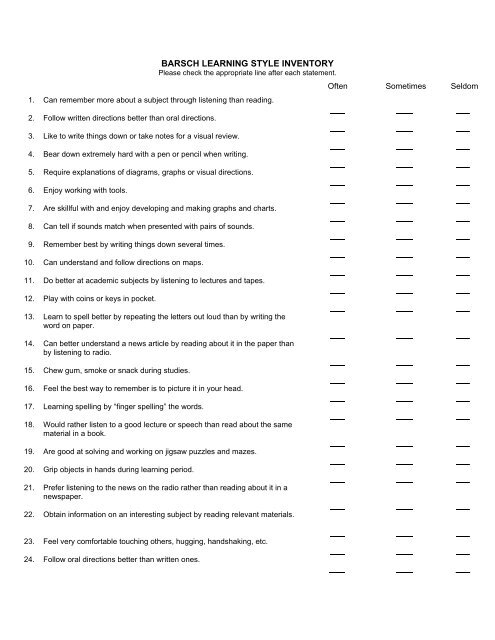

2.Goal Statements - The Five Step Approach
Goals and objectives can and should guide action. One of the 9 Principals of War is to set clearly defined, decisive, and attainable objectives. Goal or objective statements provide direction for planning, for evaluating plans and for guiding projects and actions. A "good" goal statement is SMART:
- Specific
- Measurable
- Acceptable
- Realistic
- Time bound
Specific: The goal statement should indicate what should be accomplished. It should be phrased using action words (like "design," "sell," "build," "implement,").
Measurable: The goal statement should clearly state what will be achieved and when it will be achieved?If you can measure the goal, you can dtermine if you have accomplished it. If the goal is accomplished, the project is a success.
Acceptable: Does everyone in the organization agree that the goal is necessary and desirable? Is the objective acceptable to managers and KEY stakeholders?
Realistic: This means the goal can be accomplished, but it is probably challenging. Is the goal/objective achievable?
Time bound: A goal should specify a deadline and time horizon.
Another list of criteria for evaluating goals and objectives includes:
- Acceptable - Is the objective acceptable to managers and KEY stakeholders?
- Flexible - Is the objective adaptable to unforeseen changes in the firm’s environment?
- Measurable - Does the objective clearly state what will be achieved and when it will be achieved?
- Achievable - Is the objective achievable? Can it be reached?
- Motivating - Is the objective’s target high enough to challenge, yet realistic and achievable?
- Suitable - Does the goal/objective fit with the mission statement/purpose and with other important long-term objectives?
- Understandable - Will managers at all levels understand what senior managers are trying to accomplish and achieve by setting the specific long-term objective?
A memory aid for the seven characteristics of well-defined goals and objectives is AFMAMSU
Traditional goal-setting wisdom prescribes that a good short-run goal must be a) written, b) challenging, c) believable, d) specific, e) measureable, and f) have a specific deadline.
Direct every military operation towards a clearly defined, decisive, and attainable objective.
- Using a Fixed Commitment Calendar. Purpose: Using a fixed commitment calendar helps account for all of your time, so you will be less likely to waste time. It shows you how you are using all 168 hours you get each week, and can train you to make the most of every block of time you have.

4.Job Task Analysis
- TA Assessments to Identify and Validate Job Role Requirements. Job Task Analysis (JTA) surveys are used toanalyze what tasks within a job role are most important. They are often used to construct and validate certification programs, to ensure that the questions being asked are relevant to the job.
5.Prioritized To-Do List
-Do you often feel overwhelmed by the amount of work you have to do? Do you find yourself missing deadlines? Or do you sometimes just forget to do something important, so that people have to chase you to get work done?
All of these are symptoms of not keeping a proper "To-Do List." These are prioritized lists of all the tasks that you need to carry out. They list everything that you have to do, with the most important tasks at the top of the list, and the least important tasks at the bottom.
By keeping such a list, you make sure that your tasks are written down all in one place so you don't forget anything important. And by prioritizing tasks, you plan the order in which you'll do them, so that you can tell what needs your immediate attention, and what you can leave until later.
To-Do Lists are essential if you're going to beat work overload. When you don't use them effectively, you'll appear unfocused and unreliable to the people around you.
When you do use them effectively, you'll be much better organized, and you'll be much more reliable. You'll experience less stress, safe in the knowledge that you haven't forgotten anything important. More than this, if you prioritize intelligently, you'll focus your time and energy on high-value activities, which will mean that you're more productive, and more valuable to your team.
Keeping a properly structured and thought-out list sounds simple enough. But it can be surprising how many people fail to use them at all, never mind use them effectively.
In fact, it's often when people start to use them effectively and sensibly that they make their first personal productivity breakthroughs, and start making a success of their careers. The video, below, gives some tips on how you can start to use To-Do Lists more effectively.
Using Your To-Do List
To use your list, simply work your way through it in order, dealing with the A priority tasks first, then the Bs, then the Cs, and so on. As you complete tasks, tick them off or strike them through.
What you put on your list and how you use it will depend on your situation. For instance, if you're in a sales-type role, a good way to motivate yourself is to keep your list relatively short, and aim to complete it every day.
But if you're in an operational role, or if tasks are large or dependent on too many other people, then it may be better to focus on a longer-term list, and "chip away" at it day-by-day.
Many people find it helpful to spend, say, 10 minutes at the end of the day, organizing tasks on their list for the next day.
Using Software
Although using a paper list is an easy way to get started, software-based approaches can be more efficient in spite of the learning curve. These can remind you of events or tasks that will soon be overdue, they can also be synchronized with your phone or email, and they can be shared with others on your team, if you're collaborating on a project.
There are many time management software programs available. At a simple level, you can use MSWord or MSExcel to manage your lists. Some versions of Microsoft Outlook, and other email services such as Gmail™, have task lists as standard features. Remember the Milk is another popular online task management tool that will sync with your smartphone, PDA, or email account. It can even show you where your tasks are on a map. Other similar services include Todoist and Toodledo.
One of the biggest advantages to using a software-based approach to manage your list is that you can update it easily. For example, instead of scratching off tasks and rewriting the list every day, software allows you to move and prioritize tasks quickly.
Examples
To-Do Lists can help you get, and stay, on top of important projects and piles of tasks or decisions.
For instance, imagine you're heading a team that's working on a project. There are so many tasks to do, and so many people doing them, that staying on top of it all seems overwhelming.
In this situation, structure your list by team member, writing out tasks and deadlines for every person on the project. Each day as you write out your own tasks that need completion, you can also check your Team To-Do List to see who's working on what, and if anything is due in that day. You can also include other tasks that you need to complete as part of your job.
Or, imagine you're in a sales role and have a long list of people who you need to talk to. You write out a list of everyone you need to call and every client you need to see, and start prioritizing.
You know that one client is really keen on your product and is ready to buy, so you prioritize them with an "A" – this is a prospect that's really worth focusing on. Conversely, you know that another prospect is playing you off against several competitors, meaning that you'll make less profit, and that there's a reasonable chance that you won't get the business. You prioritize this person with a "D". It's worth making some effort here, but you should focus most of your attention on better prospects.
Key Points
To be well organized in the workplace, you need to be using To-Do Lists. By using them, you will ensure that:
- You remember to carry out all necessary tasks.
- You tackle the most important jobs first, and don't waste time on trivial tasks.
- You don't get stressed by a large number of unimportant jobs.
Start by listing all of the tasks that you must carry out.
Mark the importance of the task next to it, with a priority from A (very important) to F (unimportant). Redraft the list into this order of importance. Then carry out the jobs at the top of the list first. These are the most important, most beneficial tasks to complete.
You can also use software-based approaches to manage your list. You can often access these from anywhere, and they can often be synced with your Smartphone or PDA.

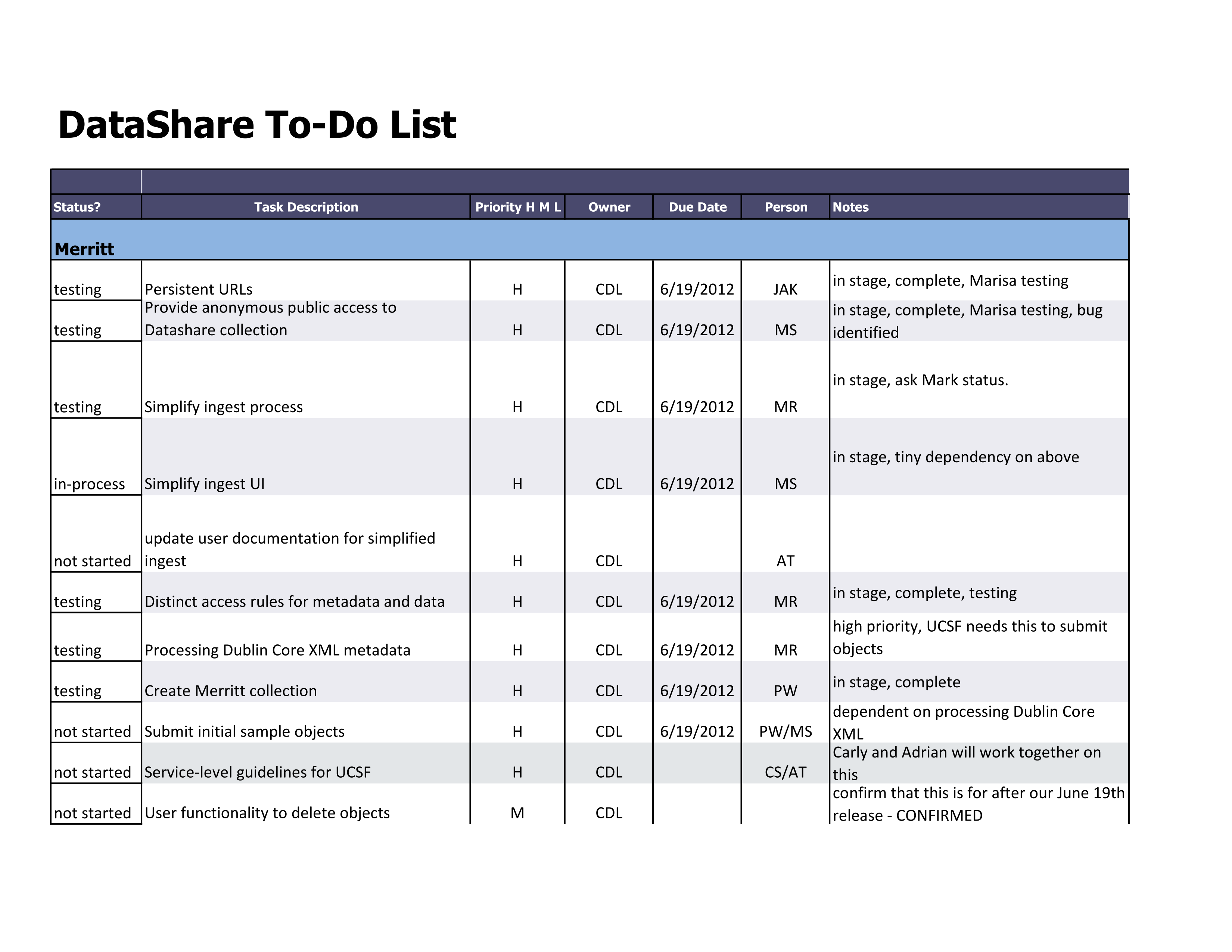
6.Memory Strategies
- Memory strategies refer to any of a broad set of techniques that are designed to help one remember. Such strategies range from everyday, external aids (e.g., using a planner) to internal memory strategies (e.g., mnemonic devices) that facilitate storage and retrieval from long-term memory.
QUICK TIPS ABOUT MEMORY
 Learning and memory are closely linked. The modal model of memory includes several stages that depend on paying attention and being mentally engaged.
Learning and memory are closely linked. The modal model of memory includes several stages that depend on paying attention and being mentally engaged.How can you build an efficient memory system?
- Pay attention! You can’t encode (take in) information without first attending to it.
- Allow time for consolidation (that is, stabilizing the memory trace after initial learning).
- To support this process, review information shortly after initial learning (e.g., right after class, at the end of the week) to establish a pathway in your brain.
- Get enough sleep! This enables transfer from short- to long-term memory. The sleeping brain reactivates the learning from that day and strengthens long-term memory.
Research suggests that…
Memory for an event or information is most likely if there is a heavy emotional component or there are multiple exposures to the material (i.e., it becomes familiar).
Tip: Preview information before class, make notes, review after class.
Quiet time for “consolidation” is required for memories to move into long- term storage.
Tip: Study or read 50 minutes, then take a 10 minute break. Repeat, take a longer (15 min) break.
Our need for sleep increases during times of intense learning and memorizing.
Tip: Get 8-9+ hours sleep during exams or other high-demand periods.
Drinking even 1-2 alcoholic drinks can impair all stages of memory, especially the transfer of information from short-term to long-term memory.
Tip: Drink moderately, avoid binging, don’t party during the week or exams.
Recall of material is improved by mimicking your learning environment.
Tip: Consider your eventual “working” conditions (e.g., exam hall or clinical setting, your desired mental or psychological state) when you are learning.

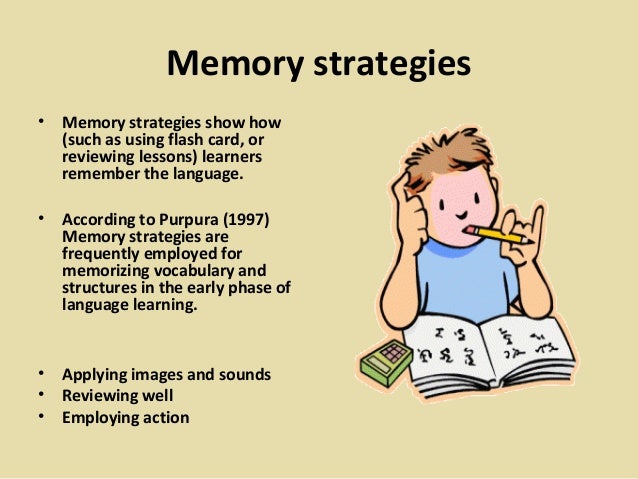
7.Organizational Strategies.
- An organizational strategy is the sum of the actions a company intends to take to achieve long-term goals. Together, these actions make up a company’s strategic plan. Strategic plans take at least a year to complete, requiring involvement from all company levels. Top management creates the larger organizational strategy, while middle and lower management adopt goals and plans to fulfill the overall strategy step by step.
Mission and Vision
Organizational strategy must arise from a company's mission, which explains why a company is in business. Every activity in the company should seek to fill this purpose, the mission thus guiding all strategic decisions. A company's vision describes what the company will have achieved in fulfilling its mission. From the vision follows the long-term goals of an organizational strategy.
Business and Functional Objectives
For a strategy to work, it must be converted into smaller, shorter-term goals and plans. Middle management adopts goals and creates plans to compete in the marketplace. These tactical objectives take less than a year to complete, becoming the building blocks of a successful organizational strategy. At the lower levels of an organization, functional managers concern themselves with the day-to-day operations of the company, their objectives and plans taking days, weeks or months to complete.
Organizational Strategy Elements
Elements important to organizational strategy include resources, scope and the company’s core competency. Because resources are finite, allocating them – people, facilities, equipment and so on – often means diverting them from somewhere else in the organization. Quantifying a strategy’s scope – for instance, becoming No. 1 in North American sales – makes for more focused plans. Finally, competitive advantage refers to what a business is best at – its core competency – along with the sum of what it knows through experience, talent and research.
The Grand Strategies
Organizational strategy falls into categories referred to as grand strategies. Grand strategies include growth, diversification, integration, retrenching and stabilizing. A growth grand strategy refers to high levels of growth achieved, for instance, by adding new locations. Diversification means expanding into new markets or adding dissimilar product lines.
Controlling supply or distribution channels instead of relying on outside companies is vertical integration. Companies achieve horizontal integration by adding similar products and services to their lineup, making them more competitive. Retrenching prunes a company back to its core competency. Companies staying the course adopt a stability strategy.

LEARNING OBJECTIVES
- Name and understand the three concentration strategies.
- Be able to explain horizontal integration and two reasons why it often fails.
For many firms, concentration strategies are very sensible. These strategies involve trying to compete successfully only within a single industry. McDonald’s, Starbucks, and Subway are three firms that have relied heavily on concentration strategies to become dominant players.
Market Penetration
There are three concentration strategies: (1) market penetration, (2) market development, and (3) product development (Figure 8.1 "Concentration Strategies"). A firm can use one, two, or all three as part of their efforts to excel within an industry.Ansoff, H. I. 1957. Strategies for diversification. Harvard Business Review, 35(5), 113–124. Market penetration involves trying to gain additional share of a firm’s existing markets using existing products. Often firms will rely on advertising to attract new customers with existing markets.
Nike, for example, features famous athletes in print and television ads designed to take market share within the athletic shoes business from Adidas and other rivals. McDonald’s has pursued market penetration in recent years by using Latino themes within some of its advertising. The firm also maintains a Spanish-language website at http://www.meencanta.com; the website’s name is the Spanish translation of McDonald’s slogan “I’m lovin’ it.” McDonald’s hopes to gain more Latino customers through initiatives such as this website.

Nike relies in part on a market penetration strategy within the athletic shoe business.
Market Development
Market development involves taking existing products and trying to sell them within new markets. One way to reach a new market is to enter a new retail channel. Starbucks, for example, has stepped beyond selling coffee beans only in its stores and now sells beans in grocery stores. This enables Starbucks to reach consumers that do not visit its coffeehouses.

Starbucks’ market development strategy has allowed fans to buy its beans in grocery stores.
Image courtesy of Claire Gribbin, http://en.wikipedia.org/wiki/File:Starbucks_coffee_beans.jpg.
Entering new geographic areas is another way to pursue market development. Philadelphia-based Tasty Baking Company has sold its Tastykake snack cakes since 1914 within Pennsylvania and adjoining states. The firm’s products have become something of a cult hit among customers, who view the products as much tastier than the snack cakes offered by rivals such as Hostess and Little Debbie. In April 2011, Tastykake was purchased by Flowers Foods, a bakery firm based in Georgia. When it made this acquisition, Flower Foods announced its intention to begin extensively distributing Tastykake’s products within the southeastern United States. Displaced Pennsylvanians in the south rejoiced.
Product Development
Product development involves creating new products to serve existing markets. In the 1940s, for example, Disney expanded its offerings within the film business by going beyond cartoons and creating movies featuring real actors. More recently, McDonald’s has gradually moved more and more of its menu toward healthy items to appeal to customers who are concerned about nutrition.
In 2009, Starbucks introduced VIA, an instant coffee variety that executives hoped would appeal to their customers when they do not have easy access to a Starbucks store or a coffeepot. The soft drink industry is a frequent location of product development efforts. Coca-Cola and Pepsi regularly introduce new varieties—such as Coke Zero and Pepsi Cherry Vanilla—in an attempt to take market share from each other and from their smaller rivals.
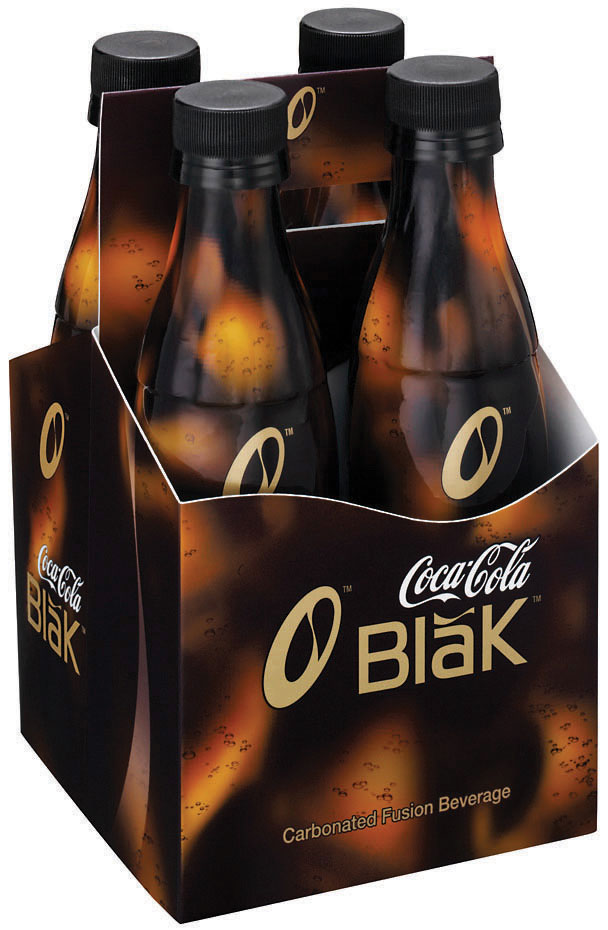
Product development is a popular strategy in the soft-drink industry, but not all developments pay off. Coca-Cola Black (a blending of cola and coffee flavors) was launched in 2006 but discontinued in 2008.
Horizontal Integration: Mergers and Acquisitions
Rather than rely on their own efforts, some firms try to expand their presence in an industry by acquiring or merging with one of their rivals. This strategic move is known as horizontal integration (Figure 8.2 "Horizontal Integration"). An acquisition takes place when one company purchases another company. Generally, the acquired company is smaller than the firm that purchases it. A merger joins two companies into one. Mergers typically involve similarly sized companies. Disney was much bigger than Miramax and Pixar when it joined with these firms in 1993 and 2006, respectively, thus these two horizontal integration moves are considered to be acquisitions.
Horizontal integration can be attractive for several reasons. In many cases, horizontal integration is aimed at lowering costs by achieving greater economies of scale. This was the reasoning behind several mergers of large oil companies, including BP and Amoco in 1998, Exxon and Mobil in 1999, and Chevron and Texaco in 2001. Oil exploration and refining is expensive. Executives in charge of each of these six corporations believed that greater efficiency could be achieved by combining forces with a former rival. Considering horizontal integration alongside Porter’s five forces model highlights that such moves also reduce the intensity of rivalry in an industry and thereby make the industry more profitable.
Some purchased firms are attractive because they own strategic resources such as valuable brand names. Acquiring Tasty Baking was appealing to Flowers Foods, for example, because the name Tastykake is well known for quality in heavily populated areas of the northeastern United States. Some purchased firms have market share that is attractive. Part of the motivation behind Southwest Airlines’ purchase of AirTran was that AirTran had a significant share of the airline business in cities—especially Atlanta, home of the world’s busiest airport—that Southwest had not yet entered. Rather than build a presence from nothing in Atlanta, Southwest executives believed that buying a position was prudent.
Horizontal integration can also provide access to new distribution channels. Some observers were puzzled when Zuffa, the parent company of the Ultimate Fighting Championship (UFC), purchased rival mixed martial arts (MMA) promotion Strikeforce. UFC had such a dominant position within MMA that Strikeforce seemed to add very little for Zuffa. Unlike UFC, Strikeforce had gained exposure on network television through broadcasts on CBS and its partner Showtime. Thus acquiring Strikeforce might help Zuffa gain mainstream exposure of its product.Wagenheim, J. 2011, March 12. UFC buys out Strikeforce in another step toward global domination. SI.com. Retrieved from http://sportsillustrated.cnn.com/2011/writers/jeff_wagenheim/03/12/strikeforce-purchased/index.html

The combination of UFC and Strikeforce into one company may accelerate the growing popularity of mixed martial arts.
KEY TAKEAWAYS
- A concentration strategy involves trying to compete successfully within a single industry.
- Market penetration, market development, and product development are three methods to grow within an industry. Mergers and acquisitions are popular moves for executing a concentration strategy, but executives need to be cautious about horizontal integration because the results are often poor.
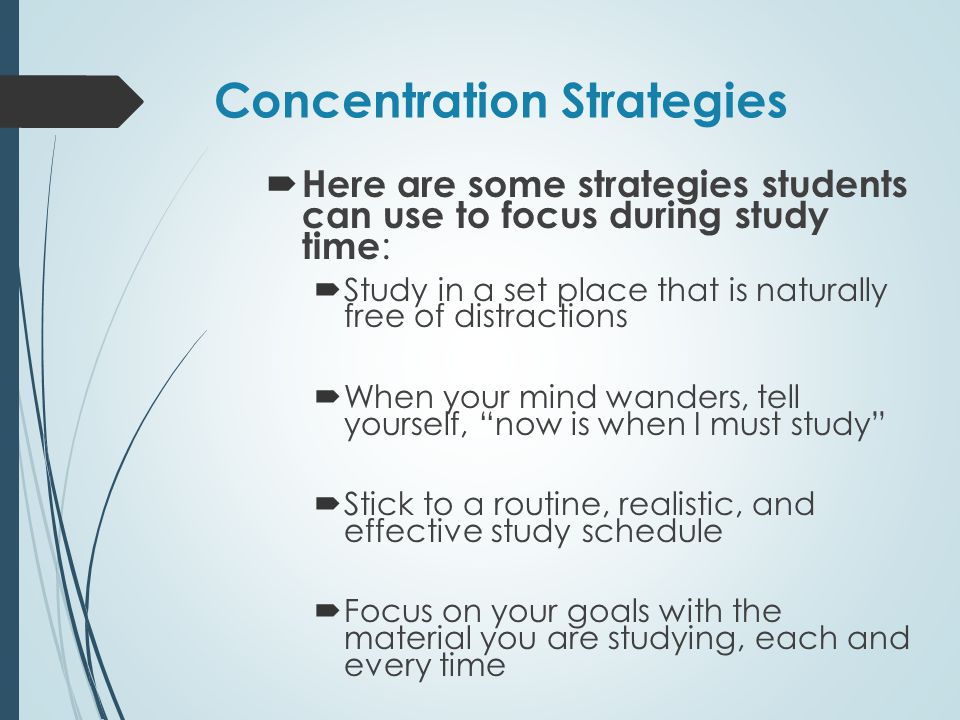
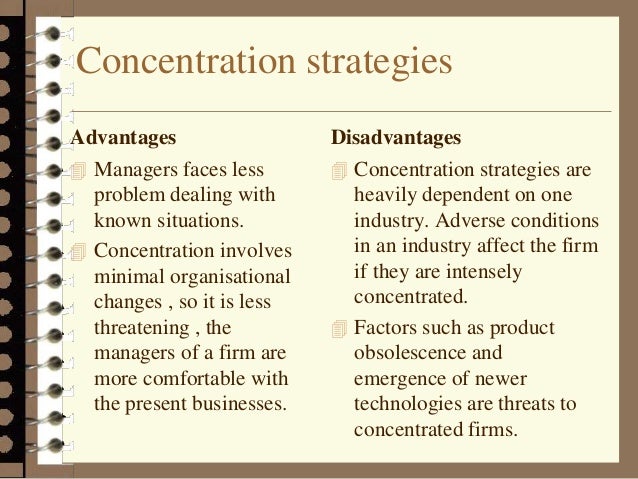
9.Concentration Chart
What is concentration?
When concentrating fully you are so absorbed in what you are doing you are unaware of time passing or of what is going on around you.…The length of time for which you can concentrate fully depends on factors such as your enthusiasm for what you are doing, your skill at a particular task, your emotional and physical state, and your surroundings at the time.
Source: Marshall, L. and Rowland, F. (1998) A Guide to Learning Independently. p. 23
What are the different kinds?
There are two types of concentration:
- Immediate concentration that allows you to observe the world around you at every moment.
- Prolongedconcentration that allows you to read, learn and think.
Studying requires you to work with your prolonged or long-term concentration. In other words, you have to minimize the attention you pay to what’s going on around you and instead focus on the task at hand.
By improving your concentration, you can:
- Maintain a higher level of attention.
- Be more efficient when studying.
- Remember what you have learned.
How to improve your concentration?
- In class:
- Pay close attention to your professor.
- Take good notes.
- Ask questions and actively participate in discussions.
- At home:
- Create a working environment that is comfortable and adapted to your needs.
- Organize your time. Set aside regular study times (with breaks and rewards).
- Establish a routine: Create for yourself a convenient ritual before getting to work (for example, put some comfortable clothes on and make yourself a snack). This routine will become a conditioned reflex that tells your brain to prepare for work.
- During exams:
- Reduce your stress by establishing better working conditions.
- Avoid sitting near windows and limit outside distractions.
- Avoid sitting beside people who work much faster than you—their pace may discourage you.
- Bring all the materials you need (pens, books, calculators—if authorized—and a snack if you need it).
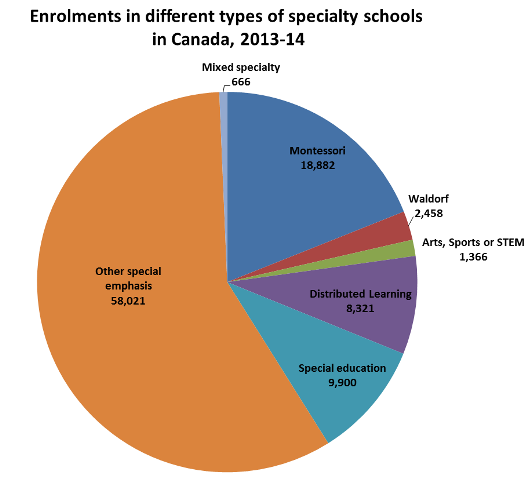



10.Reading Text
Reading comprehension is the ability to process text, understand its meaning, and to integrate with what the reader already knows.[1][2] Fundamental skills required in efficient reading comprehension are knowing meaning of words, ability to understand meaning of a word from discourse context, ability to follow organization of passage and to identify antecedents and references in it, ability to draw inferences from a passage about its contents, ability to identify the main thought of a passage, ability to answer questions answered in a passage, ability to recognize the literary devices or propositional structures used in a passage and determine its tone, to understand the situational mood (agents, objects, temporal and spatial reference points, casual and intentional inflections, etc.) conveyed for assertions, questioning, commanding, refraining etc. and finally ability to determine writer's purpose, intent and point of view, and draw inferences about the writer (discourse-semantics).[3][4]
Ability to comprehend text is influenced by reader's skills and their ability to process information. If word recognition is difficult, students use too much of their processing capacity to read individual words, which interferes with their ability to comprehend what is read. There are many reading strategies to improve reading comprehension and inferences, including improving one's vocabulary, critical text analysis (intertextuality, actual events vs. narration of events, etc.) and practicing deep reading.[5]
Overview
People learn comprehension skills through education or instruction and some learn by direct experiences.[6] Proficient reading depends on the ability to recognize words quickly and effortlessly.[7] It is also determined by an individual's cognitive development, which is "the construction of thought processes".
There are specific characteristics that determine how successfully an individual will comprehend text, including prior knowledge about the subject, well-developed language, and the ability to make inferences from methodical questioning & monitoring comprehension like: "Why is this important?" and "Do I need to read the entire text?" are examples of passage questioning.[8]
Instruction for comprehension strategy often involves initially aiding the students by social and imitation learning, wherein teachers explain genre styles and model both top-down and bottom-up strategies, and familiarize students with a required complexity of text comprehension.[9] After the contiguity interface, the second stage involves gradual release of responsibility wherein over time teachers give students individual responsibility for using the learned strategies independently with remedial instruction as required. The final stage involves leading the students to a self-regulated learning state with more and more practice and assessment.[citation needed]The teacher as reading instructor is a role model of a reader for students, demonstrating what it means to be an effective reader and the rewards of being one.[10]
Definition
Reading comprehension is the level of understanding of a text/message. This understanding comes from the interaction between the words that are written, and how they trigger knowledge outside the text/message.[11][12] Comprehension is a "creative, multifaceted process" dependent upon four language skills: phonology, syntax, semantics, and pragmatics.[13] There are 7 essential skills for reading comprehension: Decoding, Fluency, Vocabulary, Sentence Construction and Cohesion, Reasoning and background knowledge, and Working memory and attention
Reading comprehension levels
Reading comprehension involves two levels of processing, shallow (low-level) processing and deep (high-level) processing. Deep processing involves semantic processing, which happens when we encode the meaning of a word and relate it to similar words. Shallow processing involves structural and phonemic recognition, the processing of sentence and word structure, i.e. first-order logic, and their associated sounds. This theory was first identified by Fergus I. M. Craik and Robert S. Lockhart.[14]
Comprehension levels are observed through neuroimaging techniques like functional magnetic resonance imaging (fMRI). fMRI's are used to determine the specific neural pathways of activation across two conditions, narrative-level comprehension and sentence-level comprehension. Images showed that there was less brain region activation during sentence-level comprehension, suggesting a shared reliance with comprehension pathways. The scans also showed an enhanced temporal activation during narrative levels tests indicating this approach activates situation and spatial processing.[15] In general, neuroimaging studies have found that reading involves three overlapping neural systems: networks active in visual, orthography-phonology (Angular gyrus), and semantic functions (Anterior temporal lobe with Broca's and Wernicke's area). However, these neural networks are not discrete, meaning these areas have several other functions as well. The Broca's area involved in executive functions helps the a reader to vary depth of reading comprehension and textual engagement in accordance with reading goals.[16][17]
Vocabulary
Reading comprehension and vocabulary are inextricably linked together. The ability to decode or identify and pronounce words is self-evidently important, but knowing what the words mean has a major and direct effect on knowing what any specific passage means while skimming a reading material. It has been shown that students with a smaller vocabulary than other students comprehend less of what they read.[18] It has been suggested that to improve comprehension, improving word groups, complex vocabularies such as homonyms or words that have multiple meanings, and those with figurative meanings like idioms, similes, collocationsand metaphors are a good practice.[19]
Andrew Biemiller argues that teachers should give out topic related words and phrases before reading a book to students, teaching includes topic related word groups, synonyms of words and their meaning with the context, and he further says to familiarize students with sentence structures in which these words commonly occur.[20] Biemiller says this intensive approach gives students opportunities to explore the topic beyond its discourse - freedom of conceptual expansion. However, there is no evidence to suggest the primacy of this approach.[21] Incidental Morphemic analysis of words - prefixes, suffixes and roots - is also considered to improve understanding of the vocabulary, though they are proved to be an unreliable strategy for improving comprehension and is no longer used to teach students.[22]
History
Initially most comprehension teaching was based on imparting selected techniques for each genre that when taken together would allow students to be strategic readers. However, from 1930s testing various methods never seemed to win support in empirical research. One such strategy for improving reading comprehension is the technique called SQ3R introduced by Francis Pleasant Robinson in his 1946 book Effective Study.[23]
Between 1969 and 2000, a number of "strategies" were devised for teaching students to employ self-guided methods for improving reading comprehension. In 1969 Anthony V. Manzo designed and found empirical support for the Re Quest, or Reciprocal Questioning Procedure in traditional teacher-centered approach due to its sharing of "cognitive secrets." It was the first method to convert fundamental theory such as social learning into teaching methods through the use of cognitive modeling between teachers and students.[24]
Since the turn of the 20th century, comprehension lessons usually consist of students answering teacher's questions or writing responses to questions of their own, or from prompts of the teacher.[25] This detached whole group version only helped students individually to respond to portions of the text (Content area reading), and improve their writing skills.[citation needed] In the last quarter of the 20th century, evidence accumulated that academic reading test methods were more successful in assessing rather than imparting comprehension or giving a realistic insight. Instead of using the prior response registering method, research studies have concluded that an effective way to teach comprehension is to teach novice readers a bank of "practical reading strategies" or tools to interpret and analyze various categories and styles of text.[26]
Reading strategies
There are a variety of strategies used to teach reading. Strategies are key to help with reading compression. They vary according to the challenges like new concepts, unfamiliar vocabulary, long and complex sentences, etc. Trying to deal with all of these challenges at the same time may be unrealistic. Then again strategies should fit to the ability, aptitude and age level of the learner. Some of the strategies teachers use are: reading aloud, group work, and more reading exercises.[27]
Reciprocal teachingIn the 1980s Annemarie Sullivan Palincsar and Ann L. Brown developed a technique called reciprocal teaching that taught students to predict, summarize, clarify, and ask questions for sections of a text. The use of strategies like summarizing after each paragraph have come to be seen as effective strategies for building students' comprehension. The idea is that students will develop stronger reading comprehension skills on their own if the teacher gives them explicit mental tools for unpacking text.[26]
Instructional conversations
"Instructional conversations", or comprehension through discussion, create higher-level thinking opportunities for students by promoting critical and aesthetic thinking about the text. According to Vivian Thayer, class discussions help students to generate ideas and new questions. (Goldenberg, p. 317). Dr. Neil Postman has said, "All our knowledge results from questions, which is another way of saying that question-asking is our most important intellectual tool"[citation needed] (Response to Intervention). There are several types of questions that a teacher should focus on: remembering; testing understanding; application or solving; invite synthesis or creating; and evaluation and judging. Teachers should model these types of questions through "think-alouds" before, during, and after reading a text. When a student can relate a passage to an experience, another book, or other facts about the world, they are "making a connection." Making connections help students understand the author's purpose and fiction or non-fiction story.[28]
Text factors
There are factors, that once discerned, make it easier for the reader to understand the written text. One is the genre, like folktales, historical fiction, biographies or poetry. Each genre has its own characteristics for text structure, that once understood help the reader comprehend it. A story is composed of a plot, characters, setting, point of view, and theme. Informational books provide real world knowledge for students and have unique features such as: headings, maps, vocabulary, and an index. Poems are written in different forms and the most commonly used are: rhymed verse, haikus, free verse, and narratives. Poetry uses devices such as: alliteration, repetition, rhyme, metaphors, and similes. "When children are familiar with genres, organizational patterns, and text features in books they're reading, they're better able to create those text factors in their own writing." Another one is arranging the text per perceptual span and the text display favorable to the age level of the reader.[29]
Non-Verbal Imagery
Media that utilizes schema to make connections either planned or not, more commonly used within context such as: a passage, an experience, or one's imagination. Some notable examples are emojis, emoticons, cropped and uncropped images, and recently Imojis which are humorous, cropped images that are used to elicit humor and comprehension.[30]
Visualization
Visualization is a "mental image" created in a person's mind while reading text, which "brings words to life" and helps improve reading comprehension. Asking sensory questions will help students become better visualizers.[28] Students can practice visualizing by imagining what they "see, hear, smell, taste, or feel" when they are reading a page of a picture book aloud, but not yet shown the picture. They can share their visualizations, then check their level of detail against the illustrations.
Partner reading
Partner reading is a strategy created for pairs. The teacher chooses two appropriate books for the students to read.First the pupils and their parterns,must read their own book. Once they have completed this, they are given the opportunity to write down their own comprehensive questions for their partner. The students swap books, read them out loud to one another and ask one another questions about the book they read. There's are different levels of is. There are the lower ones who need extra help recording the strategys . The next level are the average but , will still need some help. There I see a good level where the children are good with no help required. And a very good level , where they are a few years ahead of their time
This strategy:
- Provides a model of fluent reading and helps students learn decoding skills by offering positive feedback.[31]
- Provides direct opportunities for a teacher to circulate in the class, observe students, and offer individual remediation.[31]
Multiple reading strategies
There are a wide range of reading strategies suggested by reading programs and educators. Effective reading strategies may differ for second language learners, as opposed to native speakers.[32][33][34] The National Reading Panel identified positive effects only for a subset, particularly summarizing, asking questions, answering questions, comprehension monitoring, graphic organizers, and cooperative learning. The Panel also emphasized that a combination of strategies, as used in Reciprocal Teaching, can be effective.[28] The use of effective comprehension strategies that provide specific instructions for developing and retaining comprehension skills, with intermittent feedback, has been found to improve reading comprehension across all ages, specifically those affected by mental disabilities.[35]
Reading different types of texts requires the use of different reading strategies and approaches. Making reading an active, observable process can be very beneficial to struggling readers. A good reader interacts with the text in order to develop an understanding of the information before them. Some good reader strategies are predicting, connecting, inferring, summarizing, analyzing and critiquing. There are many resources and activities educators and instructors of reading can use to help with reading strategies in specific content areas and disciplines. Some examples are graphic organizers, talking to the text, anticipation guides, double entry journals, interactive reading and note taking guides, chunking, and summarizing.[citation needed]
The use of effective comprehension strategies is highly important when learning to improve reading comprehension. These strategies provide specific instructions for developing and retaining comprehension skills across all ages.[36] Applying methods to attain an overt phonemic awareness with intermittent practice has been found to improve reading in early ages, specifically those affected by mental disabilities.
Comprehension Strategies
Research studies on reading and comprehension have shown that highly proficient readers utilize a number of different strategies to comprehend various types of texts, strategies that can also be used by less proficient readers in order to improve their comprehension.
- Making Inferences: In everyday terms we refer to this as “reading between the lines”. It involves connecting various parts of texts that aren’t directly linked in order to form a sensible conclusion. A form of assumption, the reader speculates what connections lie within the texts.
- Planning and Monitoring: This strategy centers around the reader’s mental awareness and their ability to control their comprehension by way of awareness. By previewing text (via outlines, table of contents, etc.) one can establish a goal for reading-“what do I need to get out of this”? Readers use context clues and other evaluation strategies to clarify texts and ideas, and thus monitoring their level of understanding.
- Asking Questions: To solidify one’s understanding of passages of texts readers inquire and develop their own opinion of the author’s writing, character motivations, relationships, etc. This strategy involves allowing oneself to be completely objective in order to find various meanings within the text.
- Determining Importance: Pinpointing the important ideas and messages within the text. Readers are taught to identify direct and indirect ideas and to summarize the relevance of each.
- Visualizing: With this sensory-driven strategy readers form mental and visual images of the contents of text. Being able to connect visually allows for a better understanding with the text through emotional responses.
- Synthesizing: This method involves marrying multiple ideas from various texts in order to draw conclusions and make comparisons across different texts; with the reader’s goal being to understand how they all fit together.
- Making Connections: A cognitive approach also referred to as “reading beyond the lines”, which involves (A) finding a personal connection to reading, such as personal experience, previously read texts, etc. to help establish a deeper understanding of the context of the text, or (B) thinking about implications that have no immediate connection with the theme of the text.[37]
Assessment
There are informal and formal assessments to monitor an individual's comprehension ability and use of comprehension strategies.[38] Informal assessments are generally through observation and the use of tools, like story boards, word sorts, and interactive writing. Many teachers use Formative assessments to determine if a student has mastered content of the lesson. Formative assessments can be verbal as in a Think-Pair-Share or Partner Share. Formative Assessments can also be Ticket out the door or digital summarizers. Formal assessments are district or state assessments that evaluates all students on important skills and concepts. Summative assessments are typically assessments given at the end of a unit to measure a student's learning.
Running records
A popular assessment undertaken in numerous primary schools around the world are running records. Running records are a helpful tool in regard to reading comprehension.[40]The tool assists teachers in analysing specific patterns in student behaviours and planning appropriate instruction. By conducting running records teachers are given an overview of students reading abilities and learning over a period of time.
In order for teachers to conduct a running record properly, they must sit beside a student and make sure that the environment is as relaxed as possible so the student does not feel pressured or intimidated. It is best if the running record assessment is conducted during reading, so there are not distractions. Another alternative is asking an education assistant to conduct the running record for you in a separate room whilst you teach/supervise the class. Quietly observe the students reading and record during this time. There is a specific code for recording which most teachers understand. Once the student has finished reading ask them to retell the story as best they can. After the completion of this, ask them comprehensive questions listed to test them on their understanding of the book. At the end of the assessment add up their running record score and file the assessment sheet away. After the completion of the running record assessment, plan strategies that will improve the students' ability to read and understand the text.

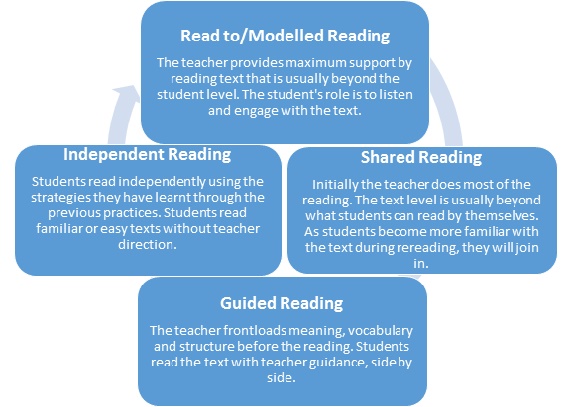
Strategies for taking good lecture notes
-Take well-organized notes in outline form
This will help you to identify the main ideas. Start large, work down to details.
This will help you to identify the main ideas. Start large, work down to details.
-Take notes in complete thoughts, but abbreviate, reduce, and simplify
Don’t try to write the profs lecture word for word. You will fall behind and miss something important. Don’t copy overheads unless the professor gives you time to do so.
Don’t try to write the profs lecture word for word. You will fall behind and miss something important. Don’t copy overheads unless the professor gives you time to do so.
-Separate and label the notes for each class
Start a new set of notes for each day, clearly separated from the day before; it makes your notes easier to study.
Start a new set of notes for each day, clearly separated from the day before; it makes your notes easier to study.
-Make your notes easy to read
It’s easier to study your notes if you can read them.
It’s easier to study your notes if you can read them.
-Be an aggressive note taker
Sit where you can hear and see the professor without straining. Stay alert.
Sit where you can hear and see the professor without straining. Stay alert.
-Start taking notes when the professor starts talking
Don’t wait for a big thought to strike you. You could easily become distracted and miss the big thought.
Don’t wait for a big thought to strike you. You could easily become distracted and miss the big thought.
-Isolate and learn the specialized vocabulary
Write down and highlight difficult or new words. Write definitions, or look them up later.
Write down and highlight difficult or new words. Write definitions, or look them up later.
-Separate facts from opinion and add your own ideas
Note what is fact and what is the professor’s opinion. Add your own thoughts; write notes directly to yourself.
Note what is fact and what is the professor’s opinion. Add your own thoughts; write notes directly to yourself.
-Develop your own set of symbols. Use them to identify or emphasize various items in your notes.
Use circles, underlines, or other symbols that will be meaningful to you.
Use circles, underlines, or other symbols that will be meaningful to you.
-Include pictures, diagrams and other visuals
Copying diagrams or other visuals helps you to understand concepts later. We tend to think in terms of pictures.
Copying diagrams or other visuals helps you to understand concepts later. We tend to think in terms of pictures.
-Take notes on discussion
Take notes when meeting with your tutor. Use notes you’ve taken in lecture to generate discussion with your tutor group.
Take notes when meeting with your tutor. Use notes you’ve taken in lecture to generate discussion with your tutor group.
-Always attend lectures to develop a complete set of notes.
Think of your lecture notes as chapters in a book, and strive to have all the chapters.
Think of your lecture notes as chapters in a book, and strive to have all the chapters.
5 Popular Note Taking Strategies
Take note of what I’m about to tell you. You have spent years taking notes in class, right? But have you ever stopped and thought, “is this note taking strategy the right one for me”?
Take a moment to reflect on your note taking strategies and figure out whether there are improvements that can be made. Make your note taking more effective. After all, having good notes will play a very important role in your final grades. Get used to creating your notes in the best possible way that suits you and follow these best practices. They will stand to you, not only this year, but next year too and, indeed, going forward into your professional life.
When taking notes in class, do not try to translate every single word the teacher says in his lecture, instead, pick up the main points. This will allow you to remember the important information. Keep reading as we investigate this point and 3 others that students around the world are using.
Note Taking Strategy Techniques
#1 Cornell Method
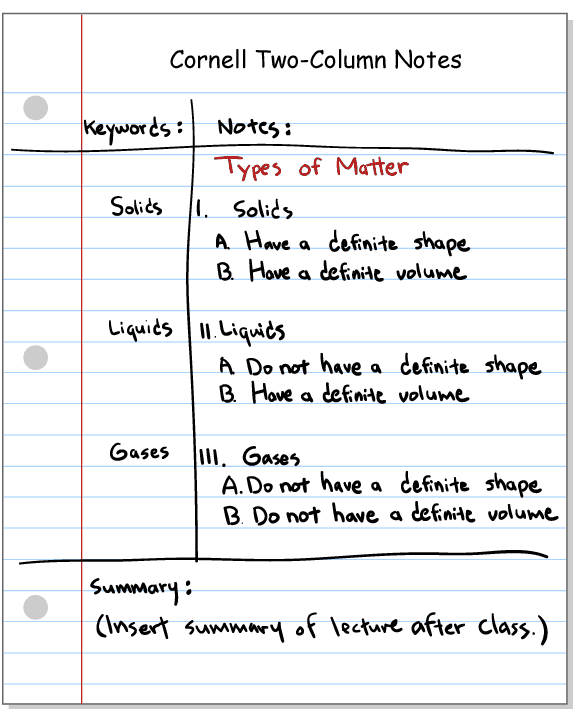 The Cornell Method has been and remains one of the most popular note-taking strategies among students today. The technique can be seen above and in the accompanying diagram. You simply divide up your notes into 3 sections. The right column is home to the general area. This is where you keep your most important ideas that the teacher has covered during class. It is important that you try to summarize as much as possible and to be smart when note-taking (see #4). The left area serves to compliment the general area. Writing notes in the margins helps us understand and relate each part of our notes. This section may develop during the class itself, or at the end of it. The last section labelled ‘summary’ should be left blank during class. It is intended for use when you are reviewing/ studying the class notes. This lessens the need to keep up with the teacher’s delivery and write fast. You should try to develop a short summary of key points in this section for greater reflection of the class notes.
The Cornell Method has been and remains one of the most popular note-taking strategies among students today. The technique can be seen above and in the accompanying diagram. You simply divide up your notes into 3 sections. The right column is home to the general area. This is where you keep your most important ideas that the teacher has covered during class. It is important that you try to summarize as much as possible and to be smart when note-taking (see #4). The left area serves to compliment the general area. Writing notes in the margins helps us understand and relate each part of our notes. This section may develop during the class itself, or at the end of it. The last section labelled ‘summary’ should be left blank during class. It is intended for use when you are reviewing/ studying the class notes. This lessens the need to keep up with the teacher’s delivery and write fast. You should try to develop a short summary of key points in this section for greater reflection of the class notes.
#2 Split Page Method
This type of Note Taking Methods have similarities with the Cornell Method however it is still a principle unto itself. The idea is that you divide the page vertically into two sections. A main idea and secondary ideas.
The idea is that, while you are taking notes, you are organising everything simultaneously. This method may require some adjustment at first but in the long run, it will help you to better optimise your study time when using our notes.
#3 Visual Aids
This method is based on the use of visual aids to improve how the brain processes information. It involves using pictures, graphs, diagrams, etc. Rather than writing long paragraphs of information, our brain follows the information sequentially. The use of colours and other visual elements such as different sized letters, also known as supernotes, favours the user. Because of this, Mind Maps are becoming one of the most widespread and effective Note Taking methods. These resources make it possible to develop ideas and connections easily in a visual environment. Our Mind Map tool includes a function that allows you to “Convert to Note“. This allows you to move all the information on your Mind Map to a digital Note with a single click. Not sure how to create a Mind Map, take a few short minutes and check out this handy article on how to create your first Mind Map.
#4 Symbols and Abbreviations
No matter which Note Taking Methods you use to take notes, there will be times when you cannot keep pace with the class and your wrist will begin to hurt you from writing. Therefore it is important that you develop your own language of symbols so that you can write more with little effort. Once the class is over, you can always “translate” your notes that you took during class. This will leave you with your own ‘language’ of notes.
#5 Underline Key Points
It’s advisable to underline the most important learning concepts of the lesson, as they will stand out more clearly and you’ll be more inclined to memorize them. In addition, the notes will be less monotonous and you can review them more quickly, since you can use the underline parts as a guide and won’t need to read the entire text every time you go to study.
These 5 note making techniques are designed to help you take more effective notes at home, in lecture halls or anywhere you have access to GoConqr. However, it is important that you adapt to your own style and stick with the ones that will bring you success. What other techniques do you use to take notes?
If you want to learn more about how to take notes efficiently don’t forget to check our blog regularly in the coming weeks as we will be publishing a series of articles about note taking.


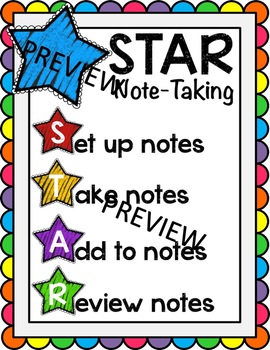
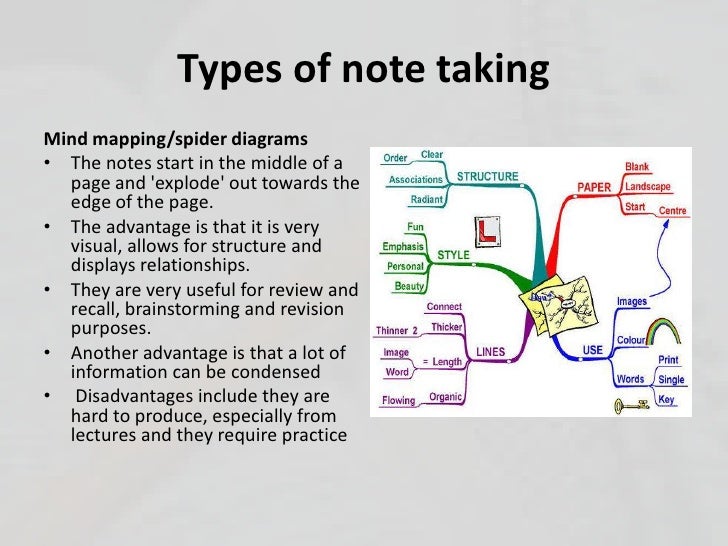
12.Note-Taking Exercise using the Cornell Method
The Cornell Note-taking System
1. Record: During the lecture, use the note-taking column to record the
lecture using telegraphic sentences.
2. Questions: As soon after class as possible, formulate questions based on
the notes in the right-hand column. Writing questions helps to clarify
meanings, reveal relationships, establish continuity, and strengthen
memory. Also, the writing of questions sets up a perfect stage for exam-studying
later.
3. Recite: Cover the note-taking column with a sheet of paper. Then, looking
at the questions or cue-words in the question and cue column only, say
aloud, in your own words, the answers to the questions, facts, or ideas
indicated by the cue-words.
4. Reflect: Reflect on the material by asking yourself questions, for example:
“What’s the significance of these facts? What principle are they based on?
How can I apply them? How do they fit in with what I already know?
What’s beyond them?
5. Review: Spend at least ten minutes every week reviewing all your previous
notes. If you do, you’ll retain a great deal for current use, as well as, for the
exam.
lecture using telegraphic sentences.
2. Questions: As soon after class as possible, formulate questions based on
the notes in the right-hand column. Writing questions helps to clarify
meanings, reveal relationships, establish continuity, and strengthen
memory. Also, the writing of questions sets up a perfect stage for exam-studying
later.
3. Recite: Cover the note-taking column with a sheet of paper. Then, looking
at the questions or cue-words in the question and cue column only, say
aloud, in your own words, the answers to the questions, facts, or ideas
indicated by the cue-words.
4. Reflect: Reflect on the material by asking yourself questions, for example:
“What’s the significance of these facts? What principle are they based on?
How can I apply them? How do they fit in with what I already know?
What’s beyond them?
5. Review: Spend at least ten minutes every week reviewing all your previous
notes. If you do, you’ll retain a great deal for current use, as well as, for the
exam.
Cornell Note Taking — The Best Way To Take Notes Explained
There are many different ways of taking notes in school or at the university. Some prefer to take a structured approach and use an outline method to take notes, some may prefer a visual way and draw mind maps, some may even use no structure at all. However, there is one note-taking technique that is superior to others in many cases and science has proven that it is not only more efficient but also makes it a lot easier to review notes, for example when preparing for an exam.
The technique we‘re referring to is called “Cornell Note Taking”. It is a system for taking, organizing and reviewing notes and has been devised by Prof. Walter Pauk of Cornell University in the 1950s.
How to use it
It requires very little preparation which makes it ideal for note taking in class. The page will be divided into 4 — or sometimes only 3 — different sections: Two columns, one area at the bottom of the page, and one smaller area at the top of the page.

The idea behind this is very easy. All actual notes from the lecture go into the main note-taking column.
The smaller column on the left side is for questions about the notes that can be answered when reviewing and keywords or comments that make the whole reviewing and exam preparation process easier.
When reviewing the notes, a brief summary of every page should be written into the section at the bottom.
When reviewing the notes, a brief summary of every page should be written into the section at the bottom.


Why should you use it?
Besides being a very efficient way of taking great notes in class, Cornell note taking is THE perfect tip for exam preparation. Why you might ask. The system itself encourages students to reflect on their notes by summarizing them briefly in their own words. Often, this can already be enough to remember study notes and to successfully pass an exam. When reviewing your notes it is useful to reorder objects on the page, for example, to add a solution to an answer on the side to the notes. Apps like GoodNotes help students to accomplish these tasks when notes are taken on an iPad.
We believe in the power of the system since it allows you to take, review and organize notes in a shorter time. Not only is it very efficient but it can also help you to achieve better grades in your exams. This is why we have included a Cornell note taking template into our free PDF template folderand encourage everyone to try it out in GoodNotes.
Instructions on how to import the template into the library in GoodNotes can also be found in the folder.
Instructions on how to import the template into the library in GoodNotes can also be found in the folder.




13.GPA Worksheet
What is a GPA?
Again, your GPA is your “grade point average,” and it is the calculated average of the grades you earn in school expressed on a numeric decimal scale of 0-4.0 or 0-5.0.
Each one of your final letter grades for a course is recorded as a letter grade (e.g. B+ in Algebra) or as a specific percent (e.g. 92% in English Literature). These grades are each converted into a number and then averaged together to come up with your GPA.
You receive a GPA at the culmination of every semester (not every quarter) that you attend high school based on the grades you earned in each of the classes you took.
Over the course of high school, starting with first semester freshman year, you’ll earn a cumulative GPA, which is an ongoing average of all of your semester grades earned so far.
Your high school creates a transcript for you which will be sent to any colleges you apply to. Your transcript is a record of all of the classes you’ve taken and the grades you’ve received in them—and presents a cumulative GPA.
In short, the sum of your performance in all of your classes across the board is reflected in your GPA.
How Do I Calculate My GPA?
You can use a handy dandy GPA calculator to crunch the numbers quickly. But remember, it’s also important that you understand how to calculate GPA if you want to understand the impact of a particular course grade on your overall GPA.
Before we move on, please note that the following explanation reflects how to calculate an unweighted GPA. This means that the GPA only reflects the average of grades earned in each class, without factoring in the difficulty of the class. Unweighted GPAs are calculated on a scale of 0-4.0. (We’ll discuss weighted GPAs in a bit more detail later.)
Step 1: Convert Each Final Grade to a Decimal
First thing’s first: Determine the decimal expression of each of your course grades. You can use this chart to determine which final letter grades correspond to which decimal values:
| Letter Grade | Percentile | GPA |
|---|---|---|
| A+ | 97-100 | 4.0 |
| A | 93-96 | 4.0 |
| A- | 90-92 | 3.7 |
| B+ | 87-89 | 3.3 |
| B | 83-86 | 3.0 |
| B- | 80-82 | 2.7 |
| C+ | 77-79 | 2.3 |
| C | 73-76 | 2.0 |
| C- | 70-72 | 1.7 |
| D+ | 67-69 | 1.3 |
| D | 65-66 | 1.0 |
| F | Below 65 | 0.0 |
Step 2: Use the GPA Calculator Formula
The GPA formula is as follows:
Sum of all decimal grades for all classes / Total number of classes you’ve taken
For example, perhaps at the end of your freshman year you took 10 classes total. The sum of all 10 final grades (as decimal values, per the chart above) is 35. Using the GPA calculator, divide 35 by 10 classes to find your GPA.
35 / 10 = 3.5 GPA
How Do I Calculate My Cumulative GPA?
If you understand the simple GPA calculator approach above, then calculating your cumulative GPA is a breeze! It just involves a few more steps. The best way to demonstrate how to calculate a cumulative GPA is to take a look at an example student’s transcript information.
Step 1: Gather Transcript Information
Let’s say the following are Maria’s grades for all four years of high school:
Step 2: Convert All Grades Into Numbers
Just like we did before, we’re going to convert the grades into decimals, except this time we’re going to do it with all of Maria’s grades, for all four years. Using the chart from earlier, this is how Maria’s grades would shake out:
| 9th Grade | 10th Grade | 11th Grade | 12th Grade |
|---|---|---|---|
| 3.0 | 4.0 | 2.7 | 3.7 |
| 3.3 | 3.0 | 3.7 | 4.0 |
| 3.0 | 4.0 | 3.3 | 2.7 |
| 2.7 | 4.0 | 2.7 | 4.0 |
| 4.0 | 3.7 | 4.0 | 3.0 |
| 3.0 | 3.0 | 3.3 | 4.0 |
| 3.7 | 4.0 | 4.0 | 4.0 |
| 3.0 | 2.7 | 2.3 | 2.3 |
| 4.0 | 3.0 | 3.0 | 4.0 |
| 3.7 | 4.0 | 4.0 | 3.0 |
| Sum: 33.4 | Sum: 35.4 | Sum: 33 | Sum: 34.7 |
The sum of all grades for all four years is 33.4 + 35.4 + 33 + 34.7 = 136.5.
Step 3: Calculate Your GPA for Each Year
For each year, divide the sum of the decimal grades by the number of classes you took that year. In this case, Maria took 10 classes each year. However, the number of classes could definitely vary by year, which is why we don’t take the average of the sum of all classes, but actually do so year-by-year.
9th Grade:
33.4 / 10 = 3.34 GPA as a freshman
33.4 / 10 = 3.34 GPA as a freshman
10th Grade:
35.4 / 10 = 3.54 GPA as a sophomore
35.4 / 10 = 3.54 GPA as a sophomore
11th Grade:
33 / 10 = 3.3 GPA as a junior
33 / 10 = 3.3 GPA as a junior
12th Grade:
34.7 /10 = 3.47 GPA as a senior
34.7 /10 = 3.47 GPA as a senior
Step 4: Use the GPA Formula to Calculate Your Cumulative GPA
If you recall from earlier, the GPA formula is:
Sum of all added decimal grades for all classes / Total number of classes you’ve taken
So in Maria’s case, the total of all her decimal grades for four years is 136.5, and Maria took 40 classes total.
So, 136.5 / 40 = 3.41. Maria’s cumulative GPA for all four years of high school is 3.41.
How Do I Calculate My GPA That Gets Submitted to Colleges?
Now, here’s a detail that throws a slight loop in the grade calculator process: college applications with transcripts typically go out at the beginning of your senior year, which means that colleges won’t see your senior year grades…yet.
In fact, this brings up two important side notes worth mentioning:
- The importance of your junior year grades
The most recent grades a college will see when you submit an application are from your 11th grade classes, so this is when you really want to push yourself to do well. This is also the last chance to significantly boost your GPA before transcripts go out if you’re not entirely thrilled with your grades in 9th and 10th grade.
- The importance of your senior year grades
If you’re following the standard college application schedule and sending out your transcripts before your final senior grades are entered, you may think this means that your senior grades don’t inform your acceptance into college. But keep in mind that nearly all colleges issue a contingency statement in their acceptance letters, requiring you to maintain the same level of academic performance that got you accepted. So even if the senioritis is strong, make sure not to slack off during your last two semesters! They can absolutely impact your college acceptance.
Okay, so back to the grade calculator. You may have already guessed that how to calculate GPA numbers that are submitted to colleges is identical to how you calculate your cumulative GPA—you just leave off senior year.
So if we return to our last example, using Maria’s transcript, it would look something like this:
101.8 (decimal totals for 9th, 10th, and 11th grade) / 30 classes = 3.39 GPA
So Maria’s GPA submitted to colleges would be 3.39.
What is the Difference Between an Unweighted and Weighted GPA?
As mentioned earlier, an unweighted GPA converts all final grades on a scale from 0-4.0. A weighted GPA, on the other hand, converts all final grades on a scale from 0-5.0, taking into consideration the difficulty of the courses.
The key difference is that grades earned in more challenging courses—including honors, IB, and AP—receive a higher numerical value, which can potentially raise a student’s overall GPA. A weighted scale is essentially put in place to reward students who do well in markedly challenging courses.
Weighted GPAs are calculated the same way unweighted ones are, and on a weighted scale, all letter grades are still turned into numerical values expressed as decimals. The difference is that grades earned in honors and AP or IB courses are assigned different values, which are as follows:
| Letter Grade | Percentile | Honors GPA | AP/IB GPA |
|---|---|---|---|
| A+ | 97-100 | 4.5 | 5.0 |
| A | 93-96 | 4.5 | 5.0 |
| A- | 90-92 | 4.2 | 4.7 |
| B+ | 87-89 | 3.8 | 4.3 |
| B | 83-86 | 3.5 | 4.0 |
| B- | 80-82 | 3.2 | 3.7 |
| C+ | 77-79 | 2.8 | 3.3 |
| C | 73-76 | 2.5 | 3.0 |
| C- | 70-72 | 2.2 | 2.7 |
| D+ | 67-69 | 1.8 | 2.3 |
| D | 65-66 | 1.5 | 2.0 |
| F | Below 65 | 0.0 | 0.0 |
Here’s an example to illustrate how grade values vary on weighted versus unweighted scales:
Let’s say Caitlin takes a regular-level biology course and earns an “A,” which is worth 4.0 on an unweighted scale. Now let’s say that her friend Ted takes an honors biology course and earns an “A” in it as well. On an unweighted scale, Ted would also receive a 4.0 for the course, since both courses convert the same, even though the course is harder.
But on a weighted scale, Caitlin would still earn the 4.0 and Ted would earn a 4.5 for earning an “A” on a weighted scale.
Now suppose that another peer, Dana, takes an AP biology course and also earns an “A” in the course. On an unweighted scale she’d earn a 4.0, but on a weighted scale she’d earn a 5.0.
How to Calculate GPA: Unweighted to Weighted
If you’re looking to convert an unweighted GPA to a weighted GPA to account for any honors, AP, or IB classes taken, follow these three easy grade calculator steps:
- Find your unweighted GPA per the instructions provided earlier, and multiply it by the number of classes taken.
- Then add .5 to the total for each honors course taken, and 1.0 for each AP or IB course taken.
- Finally, divide the results by the number of courses taken and this is your weighted GPA!
What is a Good GPA?
Now that you understand what a GPA is and how to use a grade calculator to find your GPA, let’s talk about how your GPA impacts your chances of getting into college.
Time after time, students ask, “What is a good GPA?” and the problem with that question is that “good” is a somewhat subjective term. “Good” varies based on a variety of factors: the number and difficulty of classes you’ve taken, which colleges you’re considering, etc.
Also, keep in mind that your GPA is only one of many elements in your college application, and that the colleges admissions process is complex, so you can’t hang your hat on your GPA alone. To this point, many students also ask whether GPA or standardized test scores are more important, and again, it really just all depends.
The very short answer is that no one factor is likely to make or break your chances of getting into college, generally speaking.
That said, some GPAs are obviously higher and stronger than others, and your GPA will inform where you go to college, and perhaps even your eligibility for scholarships and grants.
A good way to assess your own GPA is in relation to the national average. The national average GPA is 3.0 (on an unweighted scale), which is a “B” average. If you’re at or above this average, then you in pretty good shape!
Now, here are a couple of things to consider. First, not all graduating high school students go on to college, and those students’ GPAs are factored into that national average as well. So realistically, most college applicants have GPAs slightly higher than the national average.
If you’re aiming for a highly selective college, a “good” GPA means one that reflects at least an A- average, or a GPA of 3.5 or above; many highly selective colleges with low acceptance rates will want even higher GPAs.
On the other hand, you can definitely still get into a less selective college with a “C” average, or a 2.0 GPA, especially if the other areas of your college application are strong.
You may still be wondering one of the following questions in regards to the quality of your GPA:
“Is a GPA of _____ good?”
Is a GPA of 3.8 good? The short answer is yes, absolutely! This is near perfect on an unweighted scale, and reflects an “A” average.
Is a GPA of 3.2 good? Yes, it’s above the national average. It’s not an “A” average, and it may not be high enough for a very selective school, but it’s still a good, solid GPA.
Is a GPA of 2.2 good? Let’s say it’s satisfactory. As noted above, you can definitely still get into college with this GPA, but it reflects a “C” average, which is below the national average.
The gist is: your GPA is one part of a total package, and while some GPAs are better than others, how “good” your GPA is depends on multiple factors.
“If I get a 3.0 as a freshman, can I still get accepted into college?”
The short answer is… of course! A common—and often untrue—belief amongst teachers, parents, and students alike is that the academic standard set freshman year predicts a student’s level of achievement over the next four years.
While this may be true in some cases, we all know that freshman year is a whirlwind, and that plenty of students continue to improve their grades over the course of high school.
And, let’s say you did maintain a cumulative GPA of 3.0 by the time you’re applying to college—you’d still be right at the national average. You may not get into a moderately or highly selective college, but you can still absolutely get accepted into a college that’s a great fit for you!
What GPA Do I Need to Get Into College?
As a general rule of thumb, the lowest eligible GPA you can have when applying to colleges is a 2.0, or a “C” average.
As touched upon above, however, the GPA you need to get into college depends upon the colleges you’re applying to.
And in fact, not all colleges even have a minimum GPA requirement, although this tends to be more common among small, private, liberal arts colleges. Large public schools that receive a huge number of applications a year tend to have GPA minimums since this helps them sort applications more quickly and efficiently.
If you’re looking at highly selective colleges, you’ll want an “A” average (3.7 minimum), and the higher the GPA the better. Keep in mind too that if your school uses a weighted scale, admissions boards will definitely look closely at which classes you took and what you earned in them, paying special attention to honors, AP, and IB classes. An “A” in a regular-level course and a “B” in an AP course are numerically the same, but the fact that you took a more challenging class may be more impressive to a college.
There are some great guides out there on colleges with the highest acceptance rates and colleges with the lowest acceptance rates, as well as tools for finding the best colleges to apply to with your GPA if you’d like to gather a list of potential colleges this way.
You can also visit your guidance counselor at school for help selecting the best colleges for you based on your GPA as well as other factors such as location, programs of study, etc.
If I’m Overseas, Are My Grades Calculated the Same Way?
If you’re an international student applying for college in the United States, you may be wondering how your GPA from your home country will be interpreted by colleges that you apply to.
In short, every college or university has its own protocol and processes, and most colleges won’t ask you to try to convert your grades yourself, but will request your transcripts and analyze them in the admissions process.
Your best bet is to contact the admissions departments of any colleges you’re applying to directly to note that you are an international student, and to ask if there are any additional resources they need to help them interpret your transcripts.
For your own reference, this is an awesome international grade equivalency chart that can give you a sense of how your grades stack up on an American scale, which may be helpful as you seek out colleges.
Likewise, if you’re attending high school in the United States but are looking to attend college abroad, you can use an international grade conversion tool to get a sense of how your grades would stack up on various countries’ scales.
Final Thoughts on How to Calculate GPA
Think of your GPA as one snapshot of your entire academic experience in high school. It’s just one snapshot, but it’s an important one that captures and reflects the essence of your academic performance.
Your GPA isn’t in itself a make-or-break element of your college application. Knowing its importance early on, especially if you’re aiming for highly competitive colleges, can help you stay focused and driven to do well (even during your fullest, busiest semesters).
And remember, there are plenty of things you can do to improve your admissions odds when you have a low GPA, including doing well on your ACT or SAT and writing a great application essay. If you haven’t downloaded it already, don’t forget to get our free GPA calculator worksheet so you have a sense of how you’re doing.
Now we’d love to hear from you! Are there any pressing questions or concerns you have about GPAs in general or about calculating your GPA? Let us know in the comments below!

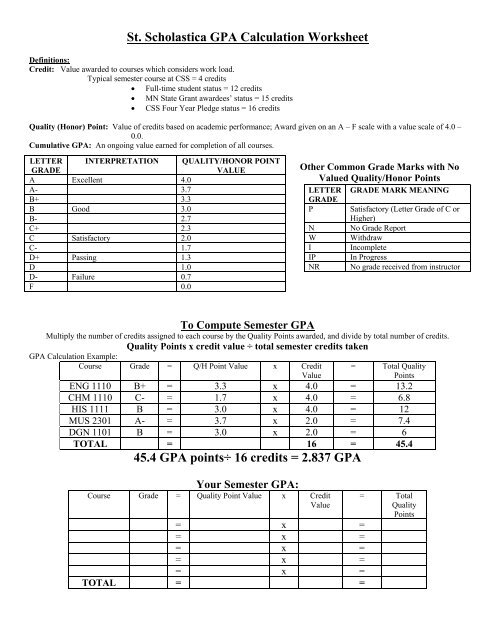
-

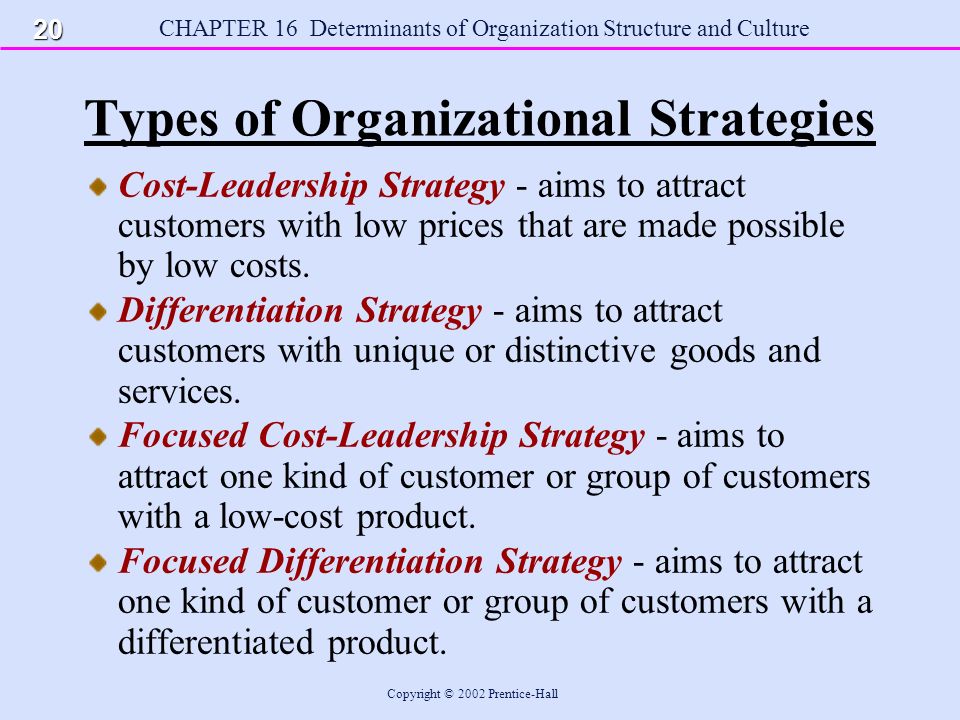
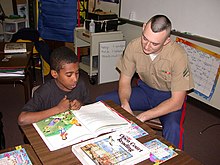

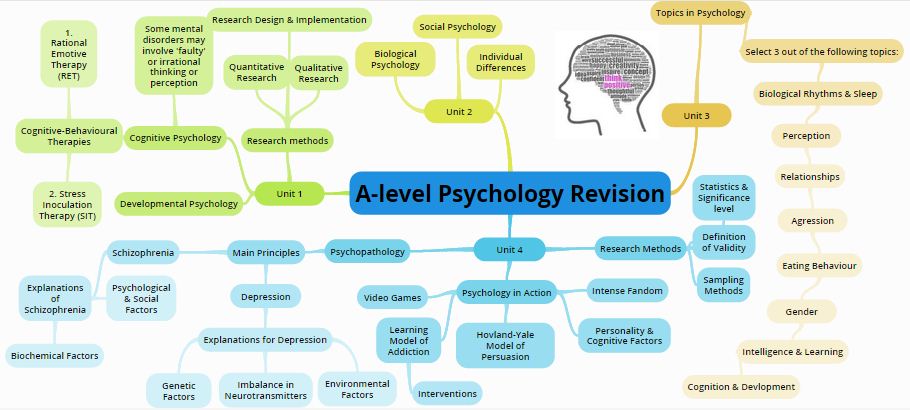




Comments
Post a Comment